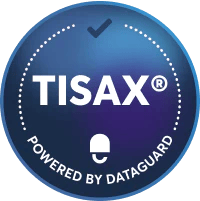Don’t miss these topics:
Related Resources
Bringing complete peace of mind
to over 4.000+ customers




Prepare effectively for your assessment on TISAX®
Learn how to assemble your team, identify essential deliverables, and navigate the assessment process with ease.
TISAX® is a registered trademark of the ENX Association. DataGuard is not affiliated with the ENX Association. We provide consultation and support for the assessment on TISAX® only. The ENX Association does not take any responsibility for any content shown on DataGuard's website.







Automotive OEMs (Original Equipment Manufacturers) and their suppliers form one of the world’s most complex supply chains. In the past, the stringent requirements prevalent in this industry meant that many individual manufacturers conducted audits of their suppliers independently. This led to suppliers having to complete multiple audits by multiple customers, costing a lot of effort, time, and money.
The Trusted Information Security Assessment Exchange (TISAX®) was developed to prevent multiple audits for companies and drive efficiency in the industry. By creating one mutually accepted standard, TISAX® can be applied across companies and even other industries without the need for additional audits. Thanks to TISAX®, a uniform level of information security is now visible and understood.
While this topic is often pushed to the IT team, TISAX® affects all business processes. For example, external auditors will examine what security measures you have in place when offboarding and onboarding new employees. The tasks involved (handover of keys or key cards, signing contracts and agreements, the creation of new email accounts) will usually be split across multiple departments. As such, all departments that play a role in the landscape of your core processes will be involved in some way: HR, Legal, IT, Office Managers, Leadership and more.
The implementation of a strong Information Security Management System (ISMS) takes six months to complete on average. You can be slightly faster, especially with the help of an expert who specialises in preparing for assessments on TISAX®.
The duration of the assessment by the external auditor depends on the size of your company and the amount of travel required between your locations. Around 2-3 days on-site to complete the assessment can be expected for an SMB-size company with around 50 employees.
This assessment can only be performed by certification companies accredited for TISAX® by the ENX Association, which runs the TISAX® scheme. The auditor will look under the hood of your ISMS to assess your processes. For example, they will take a close look at your approach to data privacy and how personal and confidential data is processed in your organisation.
Auditors will also examine your premises and what protective measures you have in place (for example, in the delivery and dispatch areas or the IT rooms).
The process is made up three assessments:
The second and third assessments can often take place several times. This will occur until your organisation has closed all the gaps - all within a maximum period of nine months. If nine months is exceeded, you must complete the initial assessment again.
The result is valid for a period of three years after which your business must repeat the assessment again.
Slash costs by up to 50% compared to conventional, external information security consultants

Scope defines your limits/boundaries for which your information security management system ISMS implementation will be applicable. Your scope should cover all your organisation’s systems, processes, physical locations, services, products and departments that need to be protected.
Examples include information stored in cloud services (Office, G-Suite), or inside tools like Salesforce, Pipedrive, Workday, Cognos, and Slack. It also includes prototyping tools like Figma and Miro or any other cloud-based tool or platform that your team uses. It should also include information on servers, information that resides with subcontractors/suppliers, information received from customers, etc.
This should cover all the ways you intend to ensure confidentiality, integrity, and availability of company information.
Your principles should ensure that your information is protected against unauthorised disclosure and unauthorised or accidental modifications (e.g., deletion or editing of the data). All information should be easily accessible for authorised users.
Nominate the responsible members of your team who will help prepare for the assessment. As noted previously, this should include a cross-section of staff, not just IT.
Regular trainings should take place to ensure that all staff are up to date on information security topics and how this affects their daily work.
You need to define rules and guidelines for how access to your information is given, controlled, and monitored.
This should cover both natural and physical risks, legal and contractual risks, compliance risks and financial risks.
Your plan should cover what possible risks can occur and how they will be responded to. For example, what would happen if your servers crash, or an important cloud service became unavailable.
This report is a detailed summary of any potential threats to your organisation. For each risk, you should determine the probability of occurrence, the resulting impact, and the security controls required to prevent it.
This document is critical to clarify your company’s requirements, expectations, and penalties regarding matters relating to business operations (e.g. service standards, deliveries, product conditions).
Include clauses for your greatest concern (e.g. how information about confidential prototypes is shared and processed).
Are you processing the personal or sensitive data of your customers? If so, auditors will check that you have the necessary measures in place to protect this data.
Define a clear method for documenting requirements for each business relationship.
The best way to determine this is to evaluate how detailed your ISMS is and how smoothly it is running. For example, your progress on risk identification, evaluation and treatment, the status of your documentation, regular management reviews and analysis, etc. An auditor will look to see if the ISMS is working in practice.
What incidents have occurred, and how many? What incidents have been prevented? Has each staff member been trained effectively? Is each objective you set out at the beginning being met?
This could be anything that you do to avoid or neutralise threats. For example, setting up a new fence or relocating your servers.
To be ready for an assessment on TISAX®, you must ensure that your ISMS is stable and effective. To find out whether it matches the expected level, you should conduct a self-assessment based on the ISA.

Join 3,000+ business leaders who stay ahead of the curve with our monthly information security newsletter.
TISAX® is a registered trademark of the ENX Association. DataGuard is not affiliated with the ENX Association. We provide consultation and support for the assessment on TISAX® only. The ENX Association does not take any responsibility for any content shown on DataGuard's website.
All data provided is for information only, based on internal estimates. This information is not indicative of KPIs, and is not given with any warranties or guarantees, expressly stated or implied in relation to accuracy and reliability.
Bringing complete peace of mind
to over 4.000+ customers







TISAX® is a registered trademark of the ENX Association. DataGuard is not affiliated with the ENX Association. We provide Software-as-a-Service and support for the assessment on TISAX® only. The ENX Association does not take any responsibility for any content shown on DataGuard's website.
All data provided is for information only, based on internal estimates. This information is not indicative of KPIs, and is not given with any warranties or guarantees, expressly stated or implied in relation to accuracy and reliability.